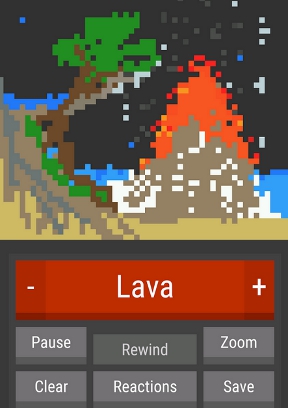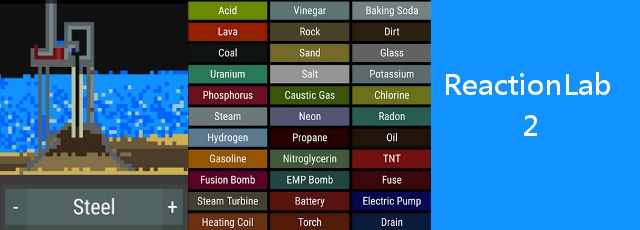![]() For everyone who ever got in trouble during science class for mixing things to see what would happen and wound up singeing their eyebrows off, H.F. Games' sandbox puzzle simulation ReactionLab for Android was basically a dream come true. With 42 different elements like fire, water, hydrogen, and radon to experiment with, you could draw onscreen and simply make explosions, discover the way certain elements interacted, or even build. Now the game is back with more mayhem in ReactionLab 2. Sporting twelve new elements, rewind and zoom functions, a save feature, and more, it's an infinitely more healthy way to get the destructive scientific genius in you the opportunity to experiment... which is what we're going to call it to be polite when you cackle softly to yourself while playing this in public and people begin edging away.
For everyone who ever got in trouble during science class for mixing things to see what would happen and wound up singeing their eyebrows off, H.F. Games' sandbox puzzle simulation ReactionLab for Android was basically a dream come true. With 42 different elements like fire, water, hydrogen, and radon to experiment with, you could draw onscreen and simply make explosions, discover the way certain elements interacted, or even build. Now the game is back with more mayhem in ReactionLab 2. Sporting twelve new elements, rewind and zoom functions, a save feature, and more, it's an infinitely more healthy way to get the destructive scientific genius in you the opportunity to experiment... which is what we're going to call it to be polite when you cackle softly to yourself while playing this in public and people begin edging away.
 ReactionLab 2 may have some puzzle elements when it comes to figuring out how to achieve the specific reactions listed in the game, but for the most part, like its predecessor it's best viewed as a creativity toy for everyone who got really excited about baking soda volcanoes in grade school, secretly wished Bill Nye was their teacher in every subject, and are looking to combine those two passions into something simple, easy, and fun. The clean user interface means playing is a simple matter of tapping buttons to swap elements and drawing on the screen with each one to see what happens next. If you tap and hold an element name in the list, it'll give you a short list of potential properties, but it seems like ReactionLab 2 might have missed an opportunity to make a really stellar educational game by just providing a bit more scientific information on both the elements and what's happening when they combine for players who want it. Being able to know mixing these two things causes something to happen is one thing, but offering information as to why it happens might have given the game a lot more staying power for the genuinely curious.
ReactionLab 2 may have some puzzle elements when it comes to figuring out how to achieve the specific reactions listed in the game, but for the most part, like its predecessor it's best viewed as a creativity toy for everyone who got really excited about baking soda volcanoes in grade school, secretly wished Bill Nye was their teacher in every subject, and are looking to combine those two passions into something simple, easy, and fun. The clean user interface means playing is a simple matter of tapping buttons to swap elements and drawing on the screen with each one to see what happens next. If you tap and hold an element name in the list, it'll give you a short list of potential properties, but it seems like ReactionLab 2 might have missed an opportunity to make a really stellar educational game by just providing a bit more scientific information on both the elements and what's happening when they combine for players who want it. Being able to know mixing these two things causes something to happen is one thing, but offering information as to why it happens might have given the game a lot more staying power for the genuinely curious.
That said, however, ReactionLab 2 is still a lot of fun, even if it's more of an upgrade to the original game than anything else. It's perfect for pulling out of your pocket and fiddling with whenever you have a chance, for as elaborate or simple creations as you please, and accessible no matter what your age, or your familiarity with games in general. If you want a literal sandbox in your pocket wherever you go and you wished you could get more hands-on with the mechanics behind games like Doodle God, ReactionLab 2 is a solid little toy that offers a good bang, fizzle, sizzle, and more for your buck.






It's amazing how this entry has acquired so many high votes, in such a short amount of time, when other mobile-only entries usually never break the 20-vote barrier...
Either JiG readers really can be motivated to look at mobile games when they're interesting, or there is vote manipulation afoot.
You might be onto something there, QWjroQ, since the game review here has more votes than the actual game on Google Play.
This game could have SO much potential if it was free (or at least had a "lite" version of the game for free).
And if it were available on Apple devices and maybe even one of the more common computer... things (Flash/Java).
You see, my high school Science students LOVE messing about on their phones. I spend a ridiculous amount of time fighting phone screens for their attention.
But if they had access to an app like this, there could be 21st century learning happening.
As an added bonus, their insatiable thirst for fire, explosions and doing experiments without any instructions or theory behind them could be somewhat quenched.
Alas, my students mostly have iThings and little to no budget for buying apps.
Since people can only vote once on any given game, there are always cases where developers may be more motivated than others to urge their fans to come and vote for their games when they are featured. We can never predict or say why or how any game might be more popular than another, just offer that as a possible explanation.
Update